Abstract
A magnetic stimulator was used for direct transcutaneous stimulation of the intracranial portion of the facial nerve in 15 normal subjects and in patients with Bell's palsy, demyelinating neuropathy, traumatic facial palsy and pontine glioma. Compound muscle action potentials (CMAPs) thus elicited in the orbicularis oris muscle of controls were of similar amplitude but longer latency (1.3 SD 0.15 ms) compared with CMAPs produced by conventional electrical stimulation at the stylomastoid foramen. No response to magnetic stimulation could be recorded from the affected side in 15 of 16 patients with Bell's palsy. Serial studies in two patients demonstrated that the facial nerve remained inexcitable by magnetic stimulation despite marked improvement in clinical function. In the patient with a pontine glioma, the CMAP elicited by transcranial magnetic stimulation was of low amplitude but normal latency. In six of seven patients with demyelinating neuropathy, the response to intracranial magnetic stimulation was significantly delayed. Magnetic stimulation produced no response in either patient with traumatic facial palsy. Although the precise site of facial nerve stimulation is uncertain, evidence points to the labyrinthine segment of the facial canal as the most likely location.
Full text
PDF
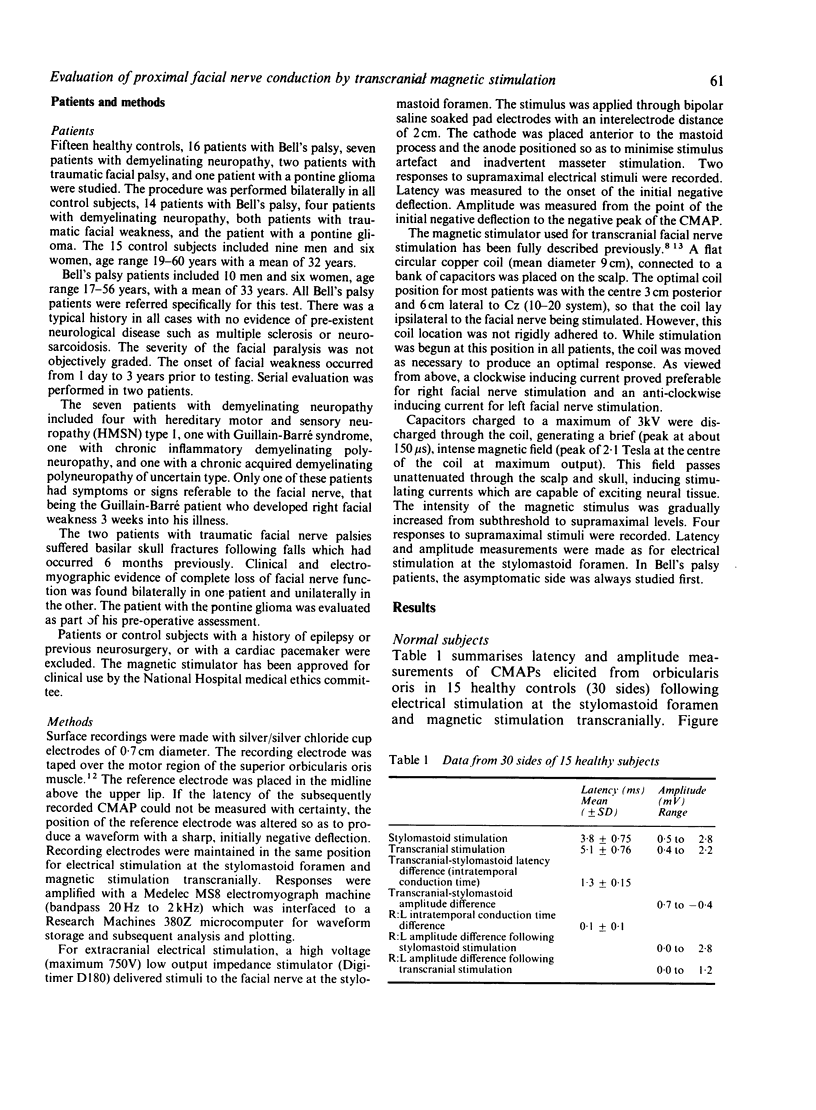
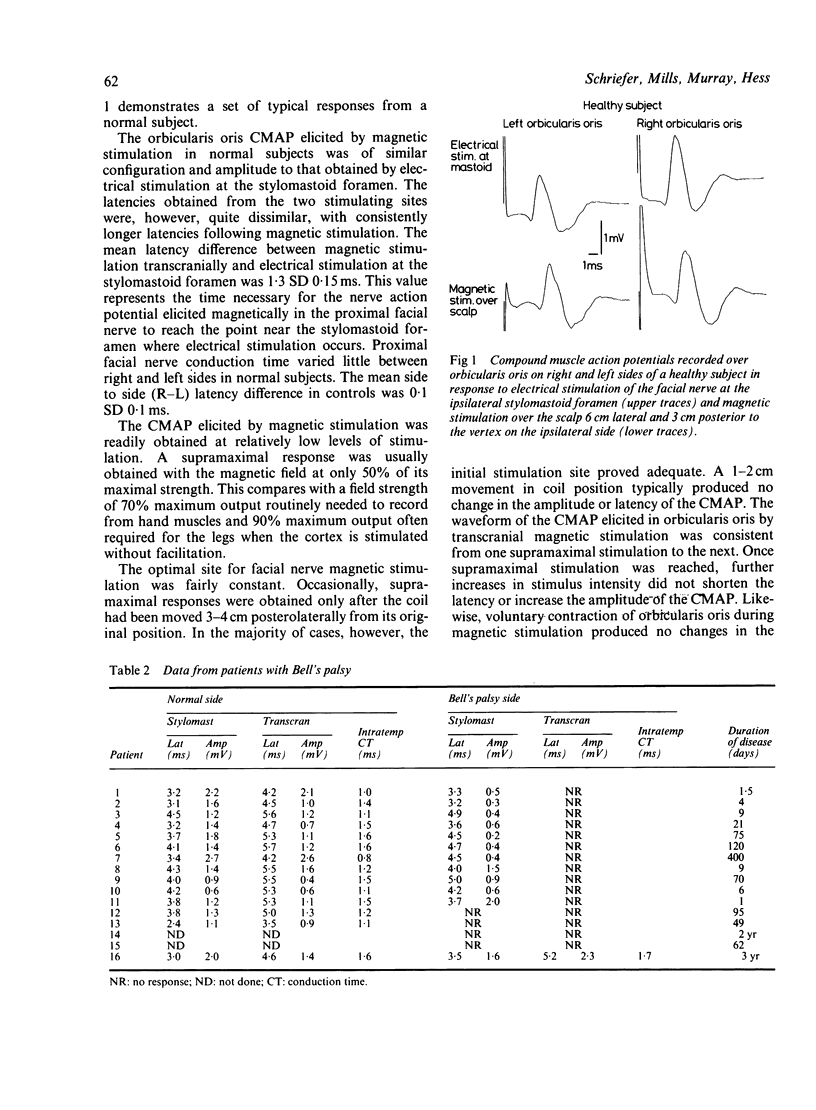
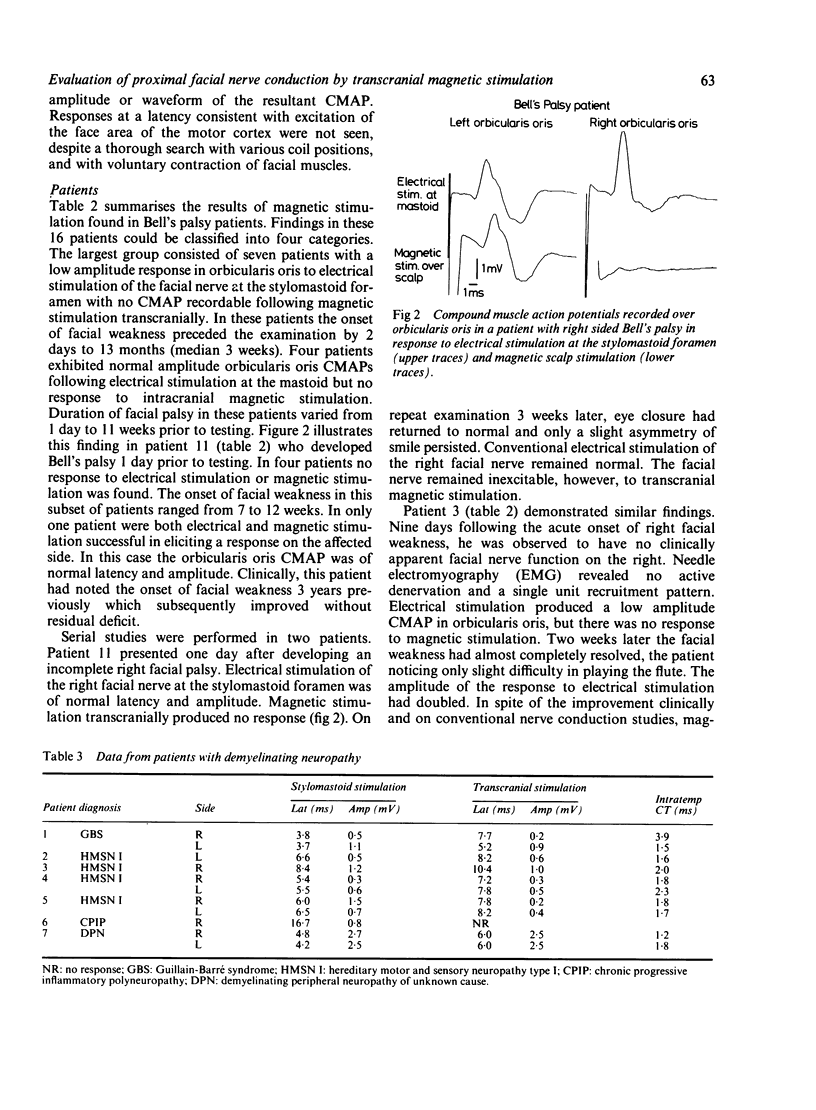
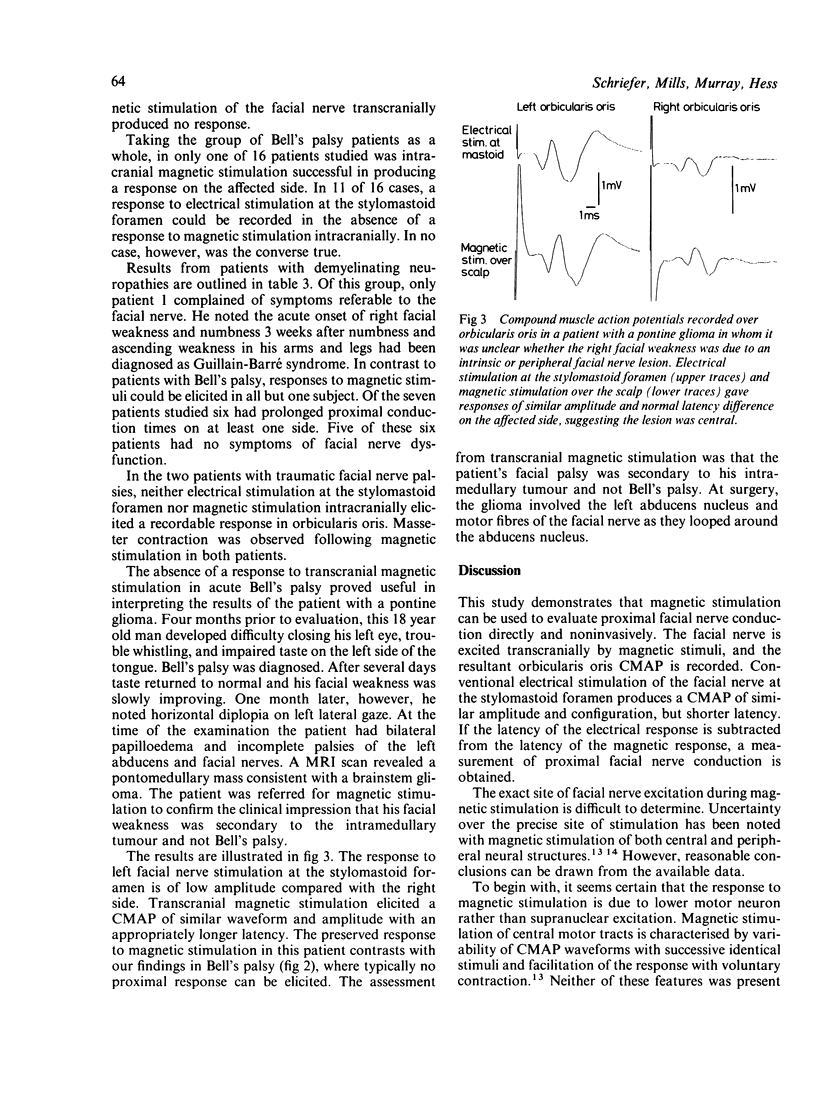
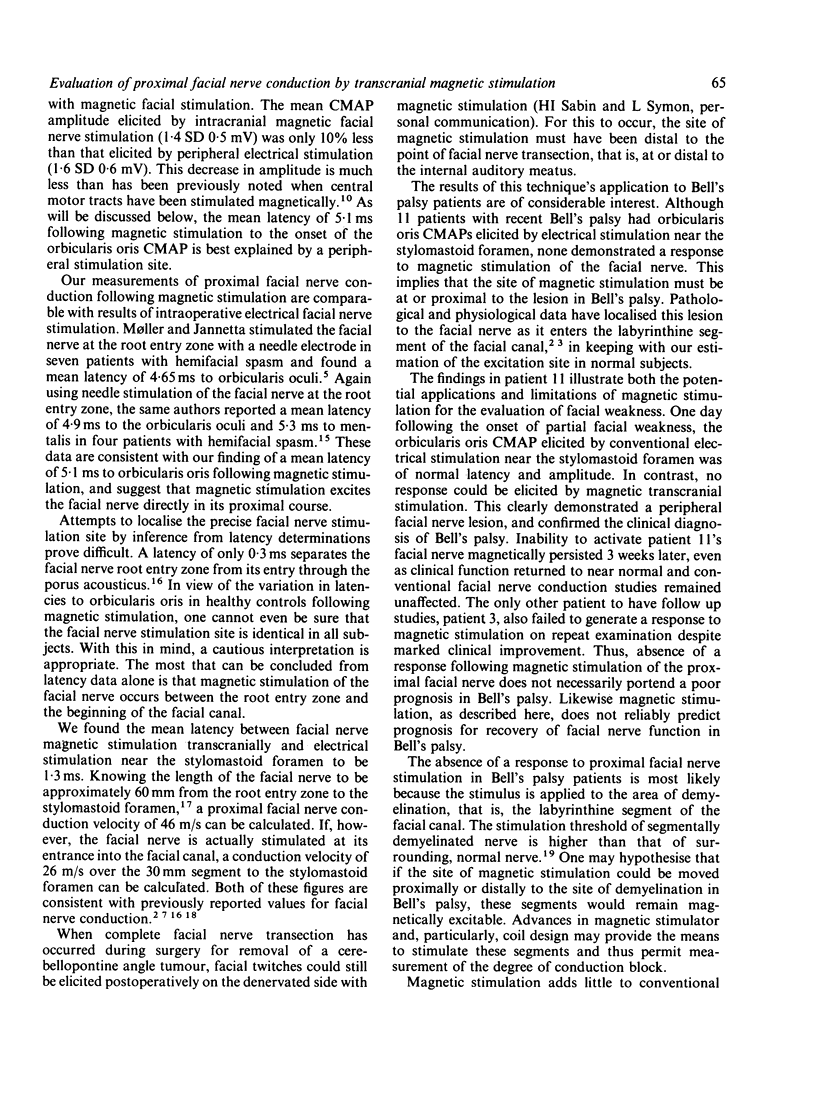
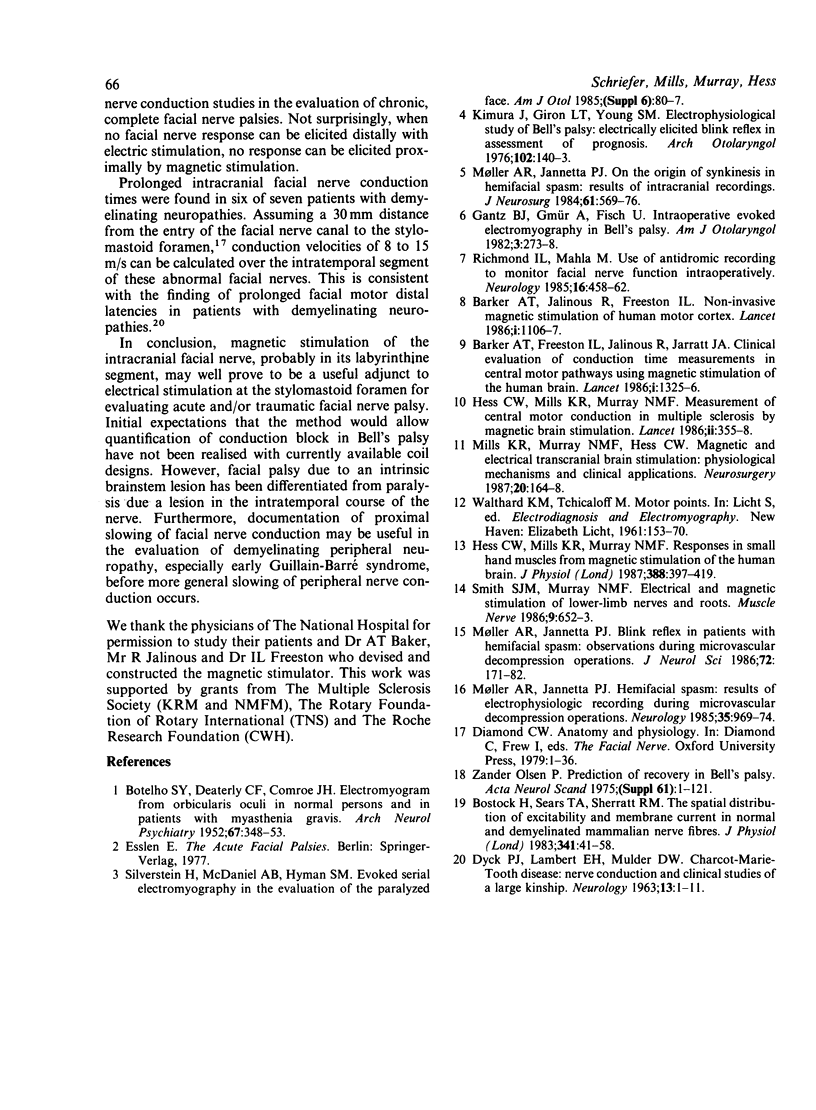
Selected References
These references are in PubMed. This may not be the complete list of references from this article.
- BOTELHO S. Y., DEATERLY C. F., COMROE J. H., Jr Electromyogram from orbicularis oculi in normal persons and in patients with myasthenia gravis. AMA Arch Neurol Psychiatry. 1952 Mar;67(3):348–353. doi: 10.1001/archneurpsyc.1952.02320150081009. [DOI] [PubMed] [Google Scholar]
- Barker A. T., Freeston I. L., Jabinous R., Jarratt J. A. Clinical evaluation of conduction time measurements in central motor pathways using magnetic stimulation of human brain. Lancet. 1986 Jun 7;1(8493):1325–1326. doi: 10.1016/s0140-6736(86)91243-2. [DOI] [PubMed] [Google Scholar]
- Barker A. T., Jalinous R., Freeston I. L. Non-invasive magnetic stimulation of human motor cortex. Lancet. 1985 May 11;1(8437):1106–1107. doi: 10.1016/s0140-6736(85)92413-4. [DOI] [PubMed] [Google Scholar]
- Bostock H., Sears T. A., Sherratt R. M. The spatial distribution of excitability and membrane current in normal and demyelinated mammalian nerve fibres. J Physiol. 1983 Aug;341:41–58. doi: 10.1113/jphysiol.1983.sp014791. [DOI] [PMC free article] [PubMed] [Google Scholar]
- Gantz B. J., Gmür A., Fisch U. Intraoperative evoked electromyography in Bell's palsy. Am J Otolaryngol. 1982 Jul-Aug;3(4):273–278. doi: 10.1016/s0196-0709(82)80066-5. [DOI] [PubMed] [Google Scholar]
- Hess C. W., Mills K. R., Murray N. M. Measurement of central motor conduction in multiple sclerosis by magnetic brain stimulation. Lancet. 1986 Aug 16;2(8503):355–358. doi: 10.1016/s0140-6736(86)90050-4. [DOI] [PubMed] [Google Scholar]
- Hess C. W., Mills K. R., Murray N. M. Responses in small hand muscles from magnetic stimulation of the human brain. J Physiol. 1987 Jul;388:397–419. doi: 10.1113/jphysiol.1987.sp016621. [DOI] [PMC free article] [PubMed] [Google Scholar]
- Kimura J., Giron L. T., Young S. M. Electrophysiological study of Bell palsy: electrically elicited blink reflex in assessment of prognosis. Arch Otolaryngol. 1976 Mar;102(3):140–143. doi: 10.1001/archotol.1976.00780080062005. [DOI] [PubMed] [Google Scholar]
- Mills K. R., Murray N. M., Hess C. W. Magnetic and electrical transcranial brain stimulation: physiological mechanisms and clinical applications. Neurosurgery. 1987 Jan;20(1):164–168. doi: 10.1097/00006123-198701000-00033. [DOI] [PubMed] [Google Scholar]
- Møller A. R., Jannetta P. J. Blink reflex in patients with hemifacial spasm. Observations during microvascular decompression operations. J Neurol Sci. 1986 Feb;72(2-3):171–182. doi: 10.1016/0022-510x(86)90005-5. [DOI] [PubMed] [Google Scholar]
- Møller A. R., Jannetta P. J. Hemifacial spasm: results of electrophysiologic recording during microvascular decompression operations. Neurology. 1985 Jul;35(7):969–974. doi: 10.1212/wnl.35.7.969. [DOI] [PubMed] [Google Scholar]
- Møller A. R., Jannetta P. J. On the origin of synkinesis in hemifacial spasm: results of intracranial recordings. J Neurosurg. 1984 Sep;61(3):569–576. doi: 10.3171/jns.1984.61.3.0569. [DOI] [PubMed] [Google Scholar]
- Olsen P. Z. Prediction of recovery in Bell's palsy. Acta Neurol Scand Suppl. 1975;61:1–121. doi: 10.1111/j.1600-0404.1975.tb01402.x. [DOI] [PubMed] [Google Scholar]
- Richmond I. L., Mahla M. Use of antidromic recording to monitor facial nerve function intraoperatively. Neurosurgery. 1985 Apr;16(4):458–462. [PubMed] [Google Scholar]


